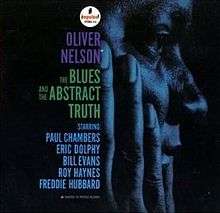The Blues and the Abstract Truth
| The Blues and the Abstract Truth | ||||||||||
|---|---|---|---|---|---|---|---|---|---|---|
 Mono LP cover (A-5)/1995 US CD issue | ||||||||||
| Studio album by Oliver Nelson | ||||||||||
| Released | August 1961[1] | |||||||||
| Recorded | February 23, 1961 | |||||||||
| Studio |
Van Gelder Studio Englewood Cliffs, New Jersey | |||||||||
| Genre | Post-bop[2] | |||||||||
| Length | 36:33 | |||||||||
| Label | Impulse! | |||||||||
| Producer | Creed Taylor | |||||||||
| Oliver Nelson chronology | ||||||||||
| ||||||||||
| Professional ratings | ||
|---|---|---|
| Review scores | ||
| Source | Rating | |
| Down Beat (Original Lp release) | ||
| AllMusic | ||
| The Rolling Stone Jazz Record Guide | ||
| Music sample | ||
| "Teenie's Blues" (stereo mix) | ||
The Blues and the Abstract Truth is an album by American composer and jazz saxophonist Oliver Nelson recorded in February 1961. It remains Nelson's most acclaimed album and features a lineup of notable musicians: Freddie Hubbard, Eric Dolphy (his second-to-last appearance on a Nelson album following a series of collaborations recorded for Prestige), Bill Evans (his only appearance with Nelson), Paul Chambers and Roy Haynes. Baritone saxophonist George Barrow does not take solos but remains a key feature in the subtle voicings of Nelson's arrangements.[6]
Music
The album is an exploration of the mood and structure of the blues, though only some of the tracks are structured in the conventional 12-bar blues form. In this regard, it may be seen as a continuation of the trend towards greater harmonic simplicity and subtlety via reimagined versions of the blues that was instigated by Miles Davis's Kind of Blue in 1959 (Evans and Chambers played on both albums).
Among the pieces on the album, "Stolen Moments" is the best known: a sixteen-bar piece in an eight-six-two pattern, even though the solos are in a conventional 12-bar minor-key blues structure in C minor. "Hoe-Down" is built on a forty-four-bar structure (with thirty-two-bar solos based on rhythm changes). "Cascades" modifies the traditional 32-bar AABA form by using a 16-bar minor blues for the A section, stretching the form to a total of 56 bars. The B-side of the album contains three tracks that hew closer to the 12-bar form: "Yearnin'", "Butch and Butch" and "Teenie's Blues" (which opens with two 12-bar choruses of bass solo by Chambers).[6]
Nelson's later album, More Blues and the Abstract Truth (1964), features an entirely different (and larger) group of musicians and bears little resemblance to this record.
Reception
Writing in the December 21, 1961 issue of Down Beat magazine jazz critic Don DeMicheal commented: "Nelson's playing is like his writing: thoughtful, unhackneyed, and well constructed. Hubbard steals the solo honors with some of his best playing on record. Dolphy gets off some good solos too, his most interesting one on "Yearnin'."[3]
The Jazz Journal International cited the album as "one of the essential post-bop recordings."[2]
Other versions/Influences
The composition "Stolen Moments" has been recorded and performed by numerous musicians including Phil Woods, J.J. Johnson, Frank Zappa, Ahmad Jamal, Booker Ervin, the United Future Organization and the Turtle Island Quartet.
"Teenie's Blues" was used as a 2009 show-opener by Steely Dan.[7]
The first eight bars of Oliver Nelson's solo on the bridge of "Hoe-Down" was quoted by Ernie Watts and Lee Ritenour in the song "Bullet Train" from their 1979 album Friendship.[8]
In 2008 pianist Bill Cunliffe released the tribute album The Blues and the Abstract Truth, Take 2, featuring new arrangements of the original pieces.
Track listing
- All tracks composed by Nelson.
- "Stolen Moments" – 8:46
- "Hoe-Down" – 4:43
- "Cascades" – 5:32
- "Yearnin'" – 6:24
- "Butch and Butch" – 4:35
- "Teenie's Blues" – 6:33
Personnel
Musicians
- Oliver Nelson – alto saxophone, tenor saxophone
- Eric Dolphy – flute, alto saxophone
- George Barrow – baritone saxophone
- Freddie Hubbard – trumpet
- Bill Evans – piano
- Paul Chambers – bass
- Roy Haynes – drums
Production
- Rudy Van Gelder – recording engineering
- Chuck Stewart – photography
- Pete Turner – cover design
References
- ↑ Khan, Ashley (2007). The House That Trane Built: The Story of Impulse Records. W. W. Norton & Company. p. 44.
- 1 2 Palmer, Richard (1990). "The Nelson Touch". Jazz Journal International. London: 10.
- 1 2 Down Beat: December 21, 1961 Vol. 28, No. 26
- ↑ Nastos, Michael G. "The Blues and the Abstract Truth: review" AllMusic. Retrieved May 20, 2013.
- ↑ Swenson, J. (Editor) (1985). The Rolling Stone Jazz Record Guide. USA: Random House/Rolling Stone. p. 151. ISBN 0-394-72643-X.
- 1 2 Oliver E. Nelson: Liner notes from Impulse! A-5, March 1961
- ↑ Rob Tannenbaum (August 4, 2009). "Tasty! Steely Dan Brings the Guitar Solos, Male Ponytails". vulture.com. Retrieved 5 January 2014.
- ↑ Electra Records album number 6E-241
External links
- The Blues and the Abstract Truth at vervemusicgroup.com
- "Album of the Week" discussion on the Organissimo jazz forum
- Bill Cunliffe's tribute to the original album (features new arrangements)
- The Blues and the Abstract Truth at discogs.com
